Asian pear tree (Pyrus pyrifolia) Profile
Written by Iris
Aug 17 2021
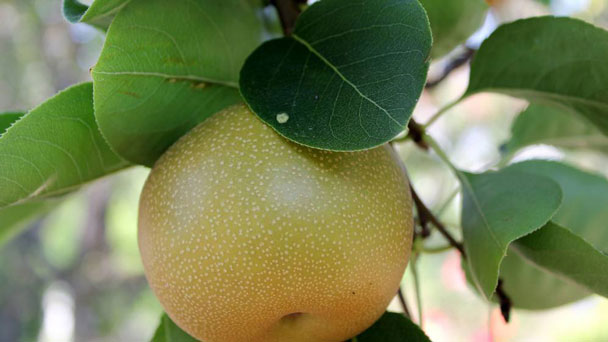
Asian pears are a large group of pears that have a crunchy texture when fully ripe, unlike European pears that must be softened before eating. Asian pears are self-bred, but produce better harvests when two or more varieties are grown together. Colder summers delay the ripening process, but warmer summers speed it up.
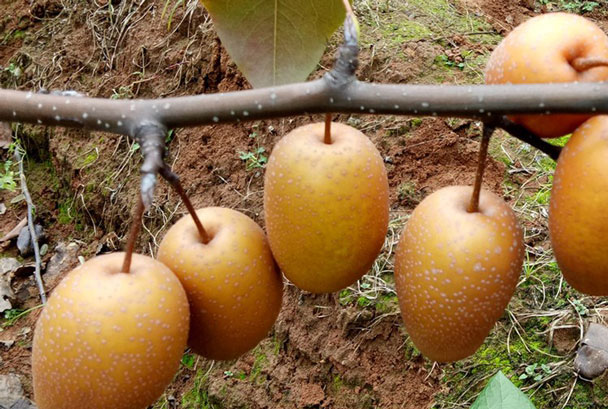
Asian pear tree (Pyrus pyrifolia) Distribution Area
Asian pears were brought to this country over 160 years ago by immigrants wanting to bring a familiar food to their new home but the fruit did not become widely popular here until the 1980's. Because they are round they are often called “apple pears” and sometimes are referred to as “water pears” because they are so juicy.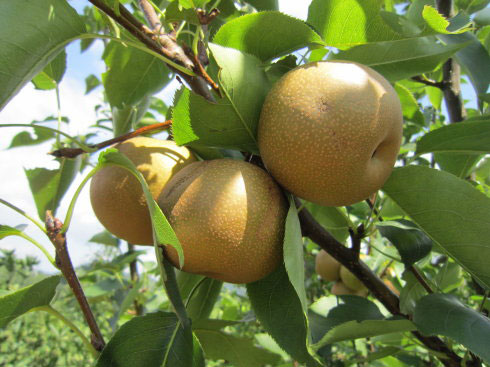
Cut it away from the tree with the pruning shears. You'll need to take at least three to six cuttings as not all will necessarily be successful. If you can, take them from two different cultivars.
Next, trim off all the leaves and any buds present on the bottom two-thirds of the cutting. New roots will actually grow from the leaf nodes.
Gently scrape off the outer bark along the bottom inch or two of the stem and around the leaf nodes, and then dip the bottom portion into your powdered rooting hormone or cloning gel.
It can take a while for the cuttings to form roots: from a few weeks to a few months. So be patient, and keep those little pear tree hopefuls warm and moist for as long as you need to.
Cut a one-foot scion from the donor tree. Cut this scion about one foot long and trim the top just above the topmost bud on the scion. Cut the bottom off just above a bud.
A whip graft is best for connecting a scion and rootstock that is less than half an inch in diameter.
Make a diagonal cut 1 1/2 inch long at the bottom of the scion.
Make a straight cut down into the scion starting about halfway down the diagonal cut.
Make an identical cut on the root stock. These two cuts will form two tongues that will mate and allow the cambium, or live growing wood of the root stock, and the scion to match up and grow together.
Slip the tongue of the scion into the tongue of the rootstock.
Tape the union securely with grafting tape.
Cover the grafting tape and graft with grafting compound to seal and secure the graft. Grafting tape and compound will help keep disease from becoming established in the fresh graft.
Make a diagonal cut 1 1/2 inch long at the bottom of the scion.
Make a straight cut down into the scion starting about halfway down the diagonal cut.
Remove the tape and grafting compound when you see new growth on the scion.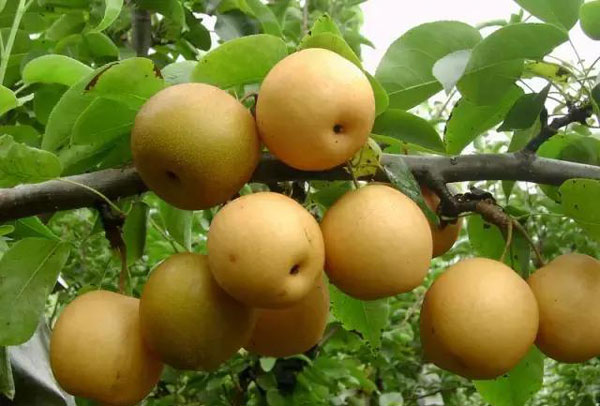
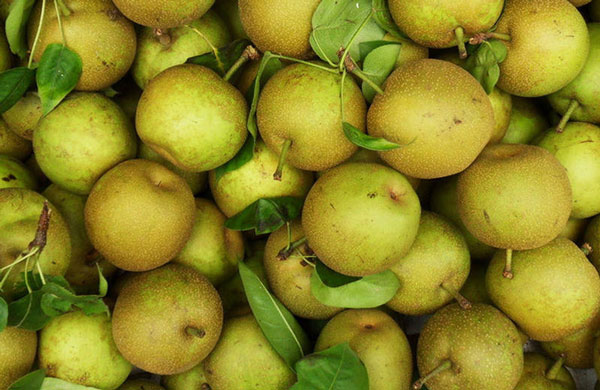
Asian pears ripen in different times starting from mid summer till late autumn.
Early ripening asian pear tree varieties (July-August): Kosui, Shinseiki, Chojuro, Ichiban, Hamese.
Mid season ripening (late summer-beginning of fall): Shinko, Hosui, Yoinashi, 20th Century (Nijisseiki) Asian Pear tree.
Late season (ripens in October-November) – Korean Giant (Olympian), Tsu Li, Sauri.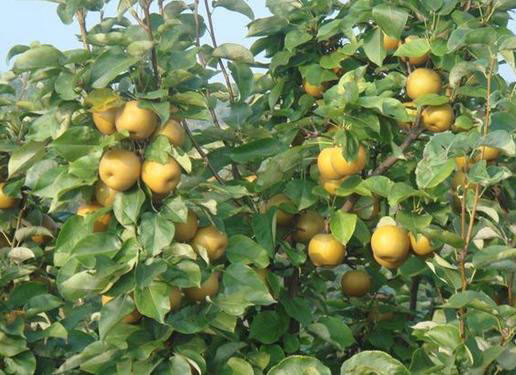
Good garden hygiene is also important. Use sharp, clean pruners to prevent damage and the spread of disease from other plants. Cleaning up dead leaves beneath the plants in the spring is also a good practice. This will help eliminate any diseases or pests which may have overwintered there.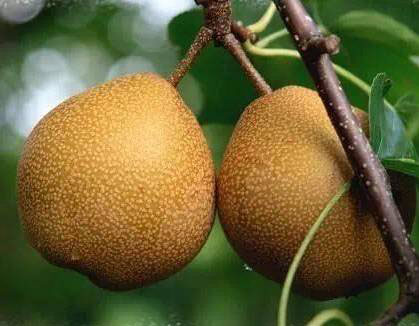
Asian pear tree (Pyrus pyrifolia) PictureAsian pear tree (Pyrus pyrifolia) InfoEcological Habits of Asian pear tree (Pyrus pyrifolia)How to Grow and Care for Asian pear tree (Pyrus pyrifolia)Varieties of Asian pear tree (Pyrus pyrifolia)Asian pear tree (Pyrus pyrifolia) Common Pests/DiseasesHarvesting and Storing Asian PearsAsian pear tree (Pyrus pyrifolia) Companion Plants
Asian pear tree (Pyrus pyrifolia) Picture

Asian pear tree (Pyrus pyrifolia) Info
| Botanical Name | Pyrus pyrifolia |
| Common Names | Asian pear, Korean pear, Japanese pear, Taiwanese pear, Chinese pear, apple pear, zodiac pear, papple, sand pear |
| Plant Type | Fruit, tree |
| Mature Size | 30–40 ft. tall, 30–40 ft. wide |
| Sun Exposure | Full |
| Soil Type | Loamy, sandy, well-drained |
| Soil pH | Acidic to neutral (6 to 8) |
| Bloom Time | Spring |
Ecological Habits of Asian pear tree (Pyrus pyrifolia)
Pyrus pyrifolia is a deciduous tree with alternate symmetrical, teardrop-shaped leaves. The small white flowers grow in clusters and cover the entire tree during the spring. Tree size ranges from 8-20 feet tall depending on the rootstock. The Asian pear is in the Rosaceae family along with apples, cherries, apricots, and plums (just to name a few). Growth and development are similar to apple trees. They bloom in the spring, the fruit tree develops over the summer, and is ready to pick at the end of summer and through the fall. In the winter, the trees drop all their leaves and go dormant. During the winter, the trees must reach a certain number of chill hours to produce fruit for the following season.Asian pear tree (Pyrus pyrifolia) Distribution Area
Asian pears were brought to this country over 160 years ago by immigrants wanting to bring a familiar food to their new home but the fruit did not become widely popular here until the 1980's. Because they are round they are often called “apple pears” and sometimes are referred to as “water pears” because they are so juicy.

How to Grow and Care for Asian pear tree (Pyrus pyrifolia)
How to Grow Asian pear tree (Pyrus pyrifolia)
- With Cuttings
Cut it away from the tree with the pruning shears. You'll need to take at least three to six cuttings as not all will necessarily be successful. If you can, take them from two different cultivars.
Next, trim off all the leaves and any buds present on the bottom two-thirds of the cutting. New roots will actually grow from the leaf nodes.
Gently scrape off the outer bark along the bottom inch or two of the stem and around the leaf nodes, and then dip the bottom portion into your powdered rooting hormone or cloning gel.
It can take a while for the cuttings to form roots: from a few weeks to a few months. So be patient, and keep those little pear tree hopefuls warm and moist for as long as you need to.
- With Grafting
Cut a one-foot scion from the donor tree. Cut this scion about one foot long and trim the top just above the topmost bud on the scion. Cut the bottom off just above a bud.
A whip graft is best for connecting a scion and rootstock that is less than half an inch in diameter.
Make a diagonal cut 1 1/2 inch long at the bottom of the scion.
Make a straight cut down into the scion starting about halfway down the diagonal cut.
Make an identical cut on the root stock. These two cuts will form two tongues that will mate and allow the cambium, or live growing wood of the root stock, and the scion to match up and grow together.
Slip the tongue of the scion into the tongue of the rootstock.
Tape the union securely with grafting tape.
Cover the grafting tape and graft with grafting compound to seal and secure the graft. Grafting tape and compound will help keep disease from becoming established in the fresh graft.
Make a diagonal cut 1 1/2 inch long at the bottom of the scion.
Make a straight cut down into the scion starting about halfway down the diagonal cut.
Remove the tape and grafting compound when you see new growth on the scion.

How to Care for Asian pear tree (Pyrus pyrifolia)
- Light
- Soil
- Water
- Temperature and Humidity
- Asian Pear Pollination
- Fruit Thinning
- Fertilizer
- Pruning

Varieties of Asian pear tree (Pyrus pyrifolia)
There are a few ways to group Asian pear tree varieties. The most common one and useful for home gardeners will be dividing Asian pear cultivars into 3 groups depending on their fruit ripening time.Asian pears ripen in different times starting from mid summer till late autumn.
Early ripening asian pear tree varieties (July-August): Kosui, Shinseiki, Chojuro, Ichiban, Hamese.
Mid season ripening (late summer-beginning of fall): Shinko, Hosui, Yoinashi, 20th Century (Nijisseiki) Asian Pear tree.
Late season (ripens in October-November) – Korean Giant (Olympian), Tsu Li, Sauri.

Asian pear tree (Pyrus pyrifolia) Common Pests/Diseases
The best defense against pests and diseases is to provide the plants with lots of sun, air drainage, adequate water drainage for the soil, and deep supplemental irrigation in the summer. Pears are susceptible to certain diseases and pests, and monitoring for problems is a good idea.Good garden hygiene is also important. Use sharp, clean pruners to prevent damage and the spread of disease from other plants. Cleaning up dead leaves beneath the plants in the spring is also a good practice. This will help eliminate any diseases or pests which may have overwintered there.

Harvesting and Storing Asian Pears
Asian pear trees hold their fruit until completely ripe in mid to late autumn, depending on variety. When wind knocks a few fruits to the ground, I start testing for ripeness by rocking fruits back and forth in my hand. Those that break off naturally are ripe. Asian pears bruise easily, so I handle them like eggs while gathering and cleaning them. The ripe fruits must be stored in the refrigerator, or they will deteriorate quickly. A tree's worth of fruits will overrun a fridge, though it's easy to make good trades with this gourmet fruit. Still, there are extras. Of the many methods I've tried for preserving Asian pears, I like drying best. A quick run through the dehydrator concentrates the sugars in Asian pear slices while causing the crisp flesh to change to leathery. The result is a delicious dried fruit to eat out of hand or add to hot cooked cereals. Cut into small tidbits, dried Asian pear can be substituted for raisins in most recipes.Asian pear tree (Pyrus pyrifolia) Companion Plants
Pear trees can be susceptible to pests, so surround them with companion plants that counteract that: Try clover, african marigolds, nasturtiums, borage, bee balm, beans, or peas.
Latest Updated
- Benefits of Bugleweed - 7 Science-backed Health Benefits
- Bugleweed Dangers & Side Effects - Is It Poisonous?
- How to Plant Evergreen Trees - What You Should Know
- When to Plant Evergreens - Grow Guide for Evergreen Trees
- 12 Wonderful Evergreen Shrubs for Your Garden
- 12 Popular Evergreen Plants with Pictures for Beginners
- When And How To Prune A Lilac Bush Like a Pro
- How to Grow & Care for Lilac Vine (Hardenbergia Violacea)
- Japanese Lilac Tree (Syringa Reticulata) Care & Propagation Guide
- Shumard Oak Pros and Cons - What to Know
Popular Articles
- Winter maintenance of Antirrhinum Majus
- How to Grow Terminalia Mantaly Tree
- How to Grow and Care for Crossostephium Chinense
- How to grow Antirrhinum Majus in spring
- Peristeria Elata (Dove Orchid) Profile: Info & Care Guide
- Underwatered Snake Plant (Sansevieria Trifasciata) - Signs And How To Fix
- How to Care for Brazilian Jasmine Plant (Mandevilla Sanderi)
- How to Grow & Care for Graptopetalum Purple Delight in Summer
- Rosa Chinensis (China Rose): Plant Growing & Care Tips
- How to Care for Baby Sun Rose (Aptenia Cordifolia)